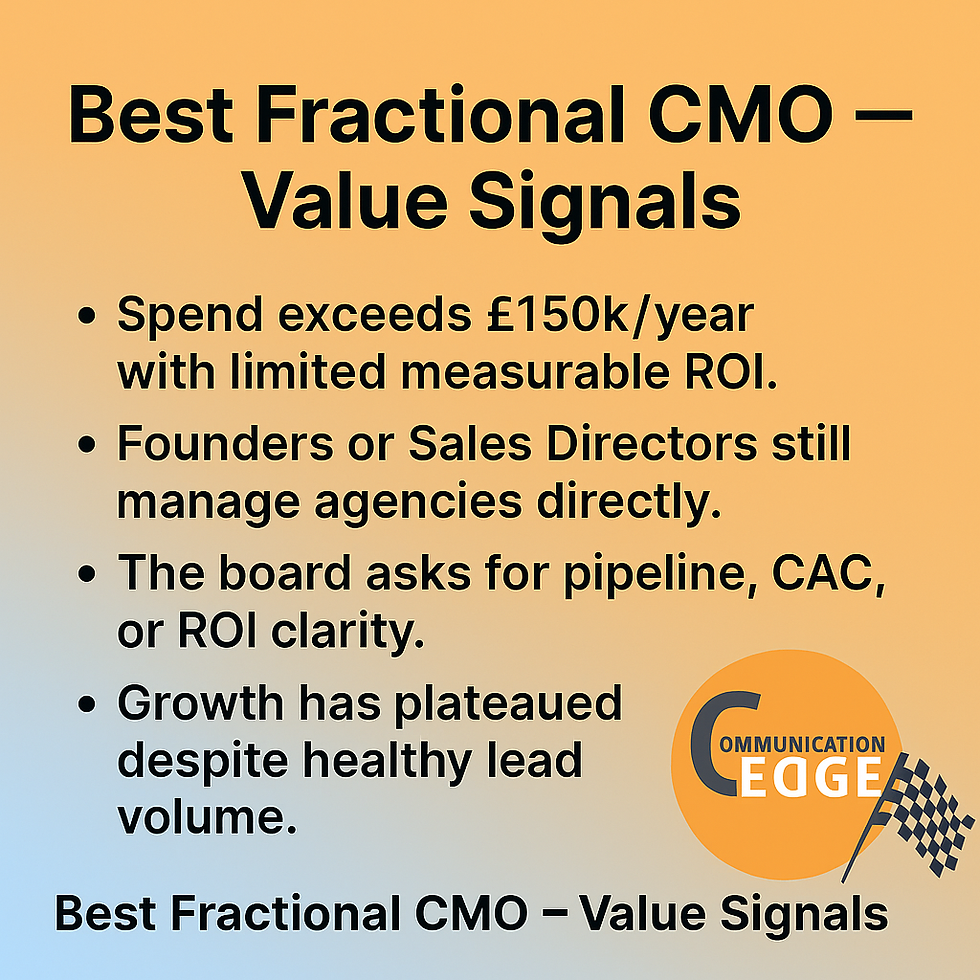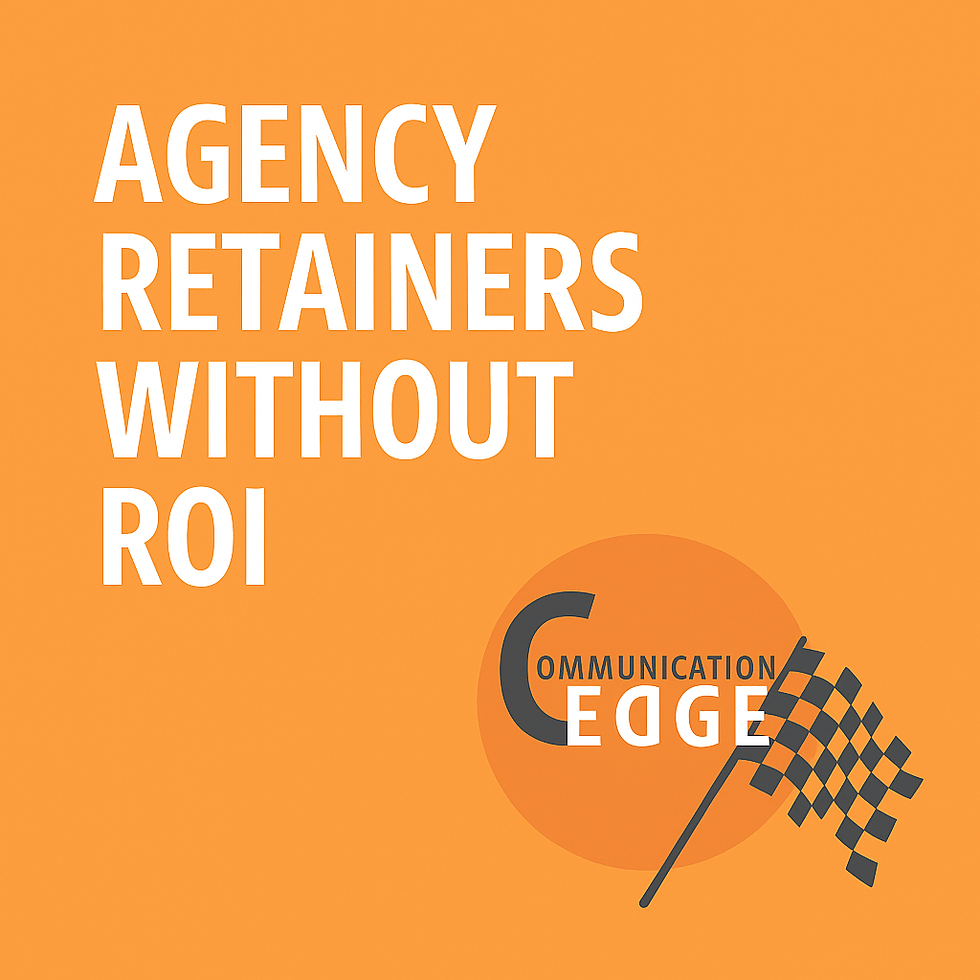“What Is Data-Driven Marketing?”
- Simon Hunt
- Oct 1
- 7 min read
Updated: Oct 18
Introduction to Data Driven Marketing

Data driven marketing is the start of moving from a "try everything" "Try something else" approach to a data informed approach - where decision are based on objective data.
Its important to note this is rather like building a house "data driven marketing" is the foundations.
Upon those foundations you then put up "the walls" or the ownership of the data.
And then "the roof" accountability for the numbers you own, understanding them and moving forward.
Definition of Data Driven Marketing
Data-driven marketing is the practice of using evidence — rather than guesswork — to plan, execute, and optimise your marketing. By analysing customer data, campaign performance, and market trends, businesses make smarter decisions that lead to higher-quality leads, lower CAC, and improved ROI.
Why Data-Driven Marketing Matters for Modern Businesses?

In fast-moving markets, intuition alone is no longer enough. Data-driven marketing enables leaders to:
Understand real customer behaviour rather than assumptions
Allocate budget to the channels that drive measurable pipeline
React quickly to performance data to stay competitive
Prove ROI to the board with clear metrics instead of vanity reports
What you get once the approach is in place: A fascination with the numbers, peeling them back, understanding the Why's? behind the numbers and exceptions.
Once that inquisitiveness is instilled in your team, knowledge gain, collective learning become a daily experience.
You effectively "kickstart" the beginning of Company IP gain as well as starting to live the too frequently glib phrase, "Team personal development and growth"
For the young Interns in Marketing this is their DNA personal advancement, learning every day, how to add value.
Key Principles of Data-Driven Marketing

A sustainable approach is built on four core principles:
Goal Alignment: Marketing objectives tied directly to commercial KPIs such as lead volume, CAC, LTV.
Reliable Data: Clean data pipelines from CRM, web analytics, ad platforms, and sales reporting.
Measurement & Feedback Loops: Dashboards that show progress in near-real time and inform optimisation.
Continuous Testing & Learning: Iterating campaigns, offers, and content based on evidence.
That's the methodology, however its the culture of learning fast, understanding the data, testing assumptions that's the real gain.
Benefits of a Data-Driven Approach

Clarity and Transparency: Clear reports everyone can understand
Budget Efficiency: Spend is redirected to activities that generate revenue, not vanity metrics
Faster Growth: Insights from analytics guide better-performing campaigns
Improved Customer Experience: Data helps tailor messaging, timing, and offers to real audience needs.
This clarity and transparency is not just a term it has real meaning to SMEs who really want to know - am I getting value from my investment in marketing.
Trust me if they can't see that value in numbers moving the right way every day, then marketing soon slips from an investment to a cost.
The moment it becomes a cost then the finance hordes descend on it trying to manage it down as a number, without understanding the context of each set of numbers , their inter-reliance and you enter the "downward spiral",
The first thing that goes is any trust you had, then any loyalty and finally its the departure door.
So the benefits are far greater : this is what you build trust and confidence with.
How Data-Driven Marketing Works in Practice
Collect Data: From web analytics, CRM, social ads, SEO tools, sales systems
Integrate & Clean: Consolidate sources to remove duplication and gaps
Analyse: Identify what channels, content and offers generate leads and conversions
Act: Adjust budget, creative and messaging based on findings
Report & Iterate: Use dashboards to monitor pipeline impact and ROI
Learn: Grow your understanding from lessons learnt, what worked, what had to be in place first.
Grow: Your marketing team's IP which will in turn be repayed with athelete like levels of marketing performance.
Common Challenges and How to Overcome Them

Data Silos: Break down platform silos by integrating CRM, website, and ad data
Complex Reporting: Use plain-language dashboards for leadership clarity
Slow Response: Put agile workflows in place to act on insights quickly
Skills Gap: Up-skill teams or bring in a Fractional CMO who understands both data and commercial outcomes
Ultimately these things are important just make sure that you test your output against two key filters:
Filter one: If I'm not around to explain the report will everyone else "get it?"
Filter two: The so what test, I'm measuring this because ...... explain the significance of every number in terms of performance relevance.
Tools and Technologies That Enable Data-Driven Marketing
Web & conversion analytics (e.g., GA4)
CRM & marketing automation (e.g., HubSpot, Salesforce)
Paid media platforms with conversion tracking (e.g., Google Ads, LinkedIn Ads)
Data visualisation & dashboards (e.g., Looker Studio, Power BI)
AI-powered tools for research, reporting and personalisation
Thankfully a lot of these tools are "free" Three Google Tools spring to mind, Lighthouse, Search Console and Analytics.
OR
They are Software as A Service and charged per seat or per module, and in each there is value.
Data driven Marketing - Case Study

Example 1 Technology Hardware and Software Company
Burning £25,000 a month with an agency.
When asked for "the numbers" relating to every key metric, you could hear the scramble for screenshots of reports being dropped onto power points.
Insight gained: They didn't live, learn, grow and die by numbers every day.
Next question, how much is it costing us per lead?
Insightful answer: "I can calculate that easily, but I don't like the number"
Insight Gained: They had never been asked the question before.
Final nail in the coffin question: Whose accountable for each process and number?
Answer "what do you mean?"
Next question "who owns Google Search, its performance, the content, the leads?
Answer: 10 minutes later - a few people with no one person either accountable for the number or the result of their efforts.
Shortly after that : All outstanding invoices the company were owed, were pulled aside and questioned.
Shortly after that: Elements of what they did were re-assigned.
Impact: Costs cut from £300k a year to £120k, now three people exists, flourish and perform with results growing every day.
Data Drive Marketing - Conclusion

If you want to think of marketing as an investment in growth - follow a data driven marketing approach.
If you do you will be rewarded with accountability & ownership of the results - as my old boss said, "what gets measured gets done"
When you get accountability what quickly follows is a knowledge growth culture as by measuring folk naturally look to understand how to influence the number.
Once you get that knowledge gain culture then your entire marketing team gains this "better never stops" attitude.
And lastly, in this ever evolving world of changing Google & LinkedIn Algorithms, new operating systems, AI engines that culture will reward you as folk get accustomed not to just adapting to change but leading the pack in driving change.
Data Driven Marketing FAQs

FAQs – What Is Data-Driven Marketing?
1. What is data-driven marketing?
Data-driven marketing uses customer and performance data to guide campaign planning, creative decisions, and budget allocation so that every activity supports measurable business goals.
2. Why is data-driven marketing important for SMEs?
It helps smaller businesses make smarter spending choices, prove ROI, and compete with larger players by focusing only on what delivers results.
3. How does data-driven marketing differ from traditional marketing?
Traditional marketing often relies on gut feel and broad messaging. Data-driven marketing relies on evidence — insights from analytics, CRM, and performance data — to personalise messaging and optimise campaigns.
4. What types of data are used in data-driven marketing?
Typical data sources include website analytics, CRM data, ad platform metrics, purchase history, email engagement, and sometimes external market research.
5. How does data-driven marketing improve ROI?
By identifying which channels and messages generate the best leads and conversions, it shifts budget away from low-return activities and doubles down on what works.
6. What skills are needed for data-driven marketing?
Teams need basic analytics knowledge, data interpretation skills, marketing automation competence, and the ability to translate insights into actionable tactics.
7. How do I start implementing data-driven marketing in my SME?
Begin by clarifying growth objectives, auditing your data sources and tracking, setting a small set of core KPIs, and testing evidence-based changes in one or two channels.
8. What tools support data-driven marketing?
Common tools include GA4 for web analytics, CRM platforms like HubSpot or Pipedrive, paid media dashboards from Google or LinkedIn, data-visualisation tools such as Looker Studio, and AI-powered research and reporting assistants.
9. How does data-driven marketing help improve customer experience?
Insights from behaviour and engagement data allow you to send more relevant offers, improve timing, personalise communication, and remove friction in the buying process.
10. What are the main challenges SMEs face in adopting data-driven marketing?
Challenges often include siloed or poor-quality data, lack of integration between tools, resistance to change, and limited in-house analytics skills.
11. How do you measure success in data-driven marketing?
Success is measured by progress against defined KPIs such as cost per lead, lead-to-customer conversion, pipeline contribution, and marketing-sourced revenue.
12. What is the role of dashboards in data-driven marketing?
Dashboards consolidate data from different sources and provide clear, real-time views of performance so decision-makers can act quickly.
13. Is data-driven marketing suitable for every business?
Almost all businesses benefit from evidence-based decisions, but the scale of implementation varies by budget, data availability, and sales cycle complexity.
14. How does data-driven marketing influence creative content?
Performance data reveals which messages, visuals, and offers resonate most with target audiences, enabling more relevant and effective creative work.
15. How is AI used in data-driven marketing?
AI can accelerate tasks such as customer segmentation, predictive lead scoring, personalised content suggestions, and reporting, freeing marketers to focus on strategy.
16. What’s the difference between being data-aware and truly data-driven?
Being data-aware means looking at reports after the fact; being data-driven means using data insights to guide planning and make real-time optimisation decisions.
17. How can SMEs ensure data privacy and compliance while using data-driven marketing?
Use only consented data, comply with GDPR and other regulations, maintain secure data storage, and keep customers informed about how their data is used.
18. How soon can SMEs see results from data-driven marketing?
Many see early improvements — such as better lead quality or lower cost per lead — within 60–90 days of implementing tracking, testing, and optimisation.
19. How does data-driven marketing help reduce wasted spend?
It highlights which campaigns, keywords, or audiences aren’t converting so that budget can be shifted or stopped before more money is lost.
20. How can a Fractional CMO support data-driven marketing in SMEs?
A Fractional CMO brings strategic expertise, selects the right KPIs, ensures data pipelines are in place, and helps the team focus on growth activities backed by evidence — without the cost of a full-time executive.





Comments